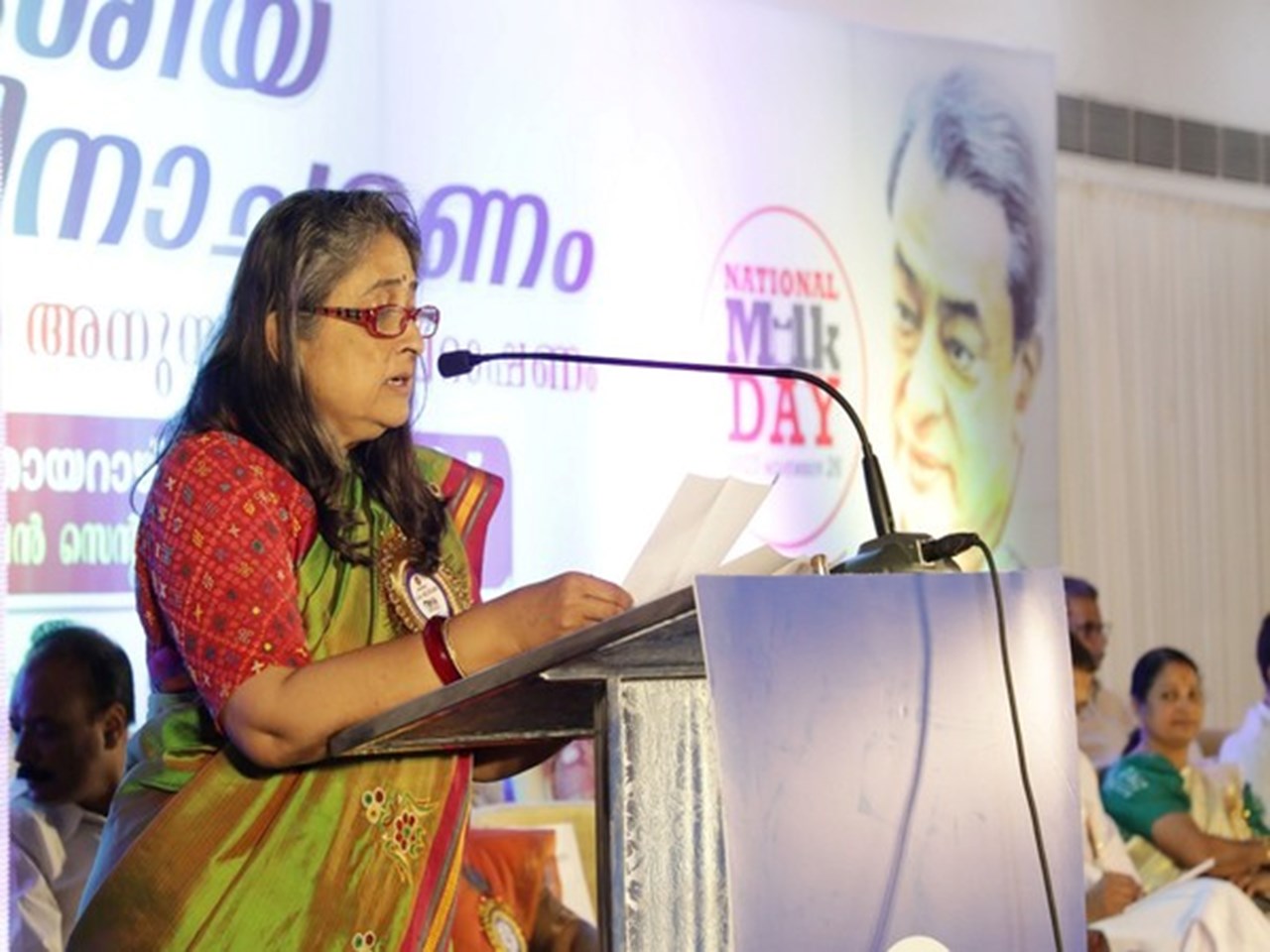Milk, egg, meat output up significantly in past five years; wool down: Report

Milk, egg, meat output up significantly in past five years; wool down: Report
New Delhi: The Union Minister for Fisheries, Animal Husbandry, and Dairying, Parshottam Rupala, presented a report on Sunday highlighting substantial increases in the production of milk, eggs, and meat during the fiscal year 2022-23 compared to the preceding five years. However, the report also indicated a negative growth trend in wool output over the same period.
The comprehensive report sheds light on the positive trajectory witnessed in the production of key animal-derived products, underscoring the agricultural sector’s contributions to the nation’s economy. The data provides valuable insights into the evolving landscape of animal husbandry and its varied impacts on different sub-sectors.
In the realm of dairy production, the report reveals a noteworthy surge in milk output, indicating the robust performance of the dairy industry. The increased production aligns with the growing demand for dairy products in the country, driven by factors such as population growth, rising income levels, and changing dietary preferences. The dairy sector’s resilience and capacity for expansion are evident in the reported growth figures.
Similarly, the uptick in egg production is indicative of advancements in poultry farming and the poultry industry’s response to increasing demand for eggs. The growth in egg production reflects not only improved efficiency in poultry operations but also the industry’s ability to adapt to evolving market dynamics.
The report also highlights a significant rise in meat production, emphasizing the diverse contributions of the meat sector to the overall animal husbandry landscape. Increased meat production can be attributed to factors such as heightened consumer demand, improved breeding practices, and advancements in animal husbandry techniques.
Conversely, the negative growth observed in wool output underscores challenges faced by the wool sector, potentially influenced by factors such as changing consumer preferences, competition from synthetic materials, or challenges in the wool supply chain.
In presenting the report, Minister Parshottam Rupala aims to provide stakeholders, policymakers, and the public with a comprehensive overview of the trends and dynamics within the fisheries, animal husbandry, and dairying sectors. The data serves as a valuable resource for assessing the performance of these sectors, formulating informed policies, and promoting sustainable practices in animal agriculture.
The Basic Animal Husbandry Statistics 2023 report was unveiled during a National Milk Day event in Guwahati, offering comprehensive insights into the state of animal husbandry in India. Minister Parshottam Rupala presented the report, emphasizing its significance in understanding and assessing the trends, challenges, and opportunities within the country’s diverse and dynamic animal husbandry sector.
The report draws on data collected through the Animal Integrated Sample Survey conducted over the period from March 2022 to February 2023. This extensive survey spans three distinct seasons—summer (March-June), monsoon (July-October), and winter (November-February)—providing a nuanced and seasonally representative perspective on animal husbandry practices across the nation.
National Milk Day, observed on the birth anniversary of Dr. Verghese Kurien, the father of India’s White Revolution, serves as a fitting occasion to release a report that delves into the key components of the dairy sector. India’s dairy industry has experienced substantial growth over the years, making it a vital contributor to the agricultural economy.
Milk production, a pivotal aspect of the report, witnessed a significant increase during the fiscal year 2022-23. This growth aligns with the country’s continued efforts to enhance dairy infrastructure, promote scientific breeding practices, and bolster the dairy cooperative movement. The surge in milk production not only addresses domestic demand but also positions India as a major player in the global dairy market.
The report’s coverage extends beyond milk production to encompass other crucial facets of animal husbandry, including egg and meat production. The positive trends observed in these areas underscore the multifaceted contributions of animal agriculture to food security, livelihoods, and economic development.
While celebrating the successes in dairy, poultry, and meat production, the report also sheds light on challenges faced by the wool sector, where negative growth has been reported. Understanding the dynamics of each sub-sector is crucial for formulating targeted interventions, policies, and strategies to address specific challenges and unlock the full potential of India’s diverse animal husbandry practices.
As the report becomes a valuable reference for policymakers, researchers, and stakeholders, it will play a pivotal role in shaping the trajectory of animal husbandry in India. By fostering sustainable and inclusive growth, the insights gleaned from the report contribute to the overarching goal of enhancing the well-being of farmers, ensuring food security, and promoting resilient agricultural practices.
India’s dairy sector witnessed a robust growth trajectory, with milk production surging by 3.8% to reach 230.58 million tonnes during the fiscal year 2022-23, according to the Basic Animal Husbandry Statistics 2023 report. Uttar Pradesh emerged as the leading contributor, accounting for 15.7% of the total milk production, followed by Rajasthan (14.44%), Madhya Pradesh (8.73%), Gujarat (7.49%), and Andhra Pradesh (6.70%).
Uttar Pradesh, with its diverse agro-climatic zones and significant investments in dairy infrastructure, played a pivotal role in driving the overall growth of India’s milk production. The state recorded an annual growth rate of 6.99%, contributing substantially to the national increase.
Other states that made noteworthy contributions to the positive momentum in milk production include Rajasthan, Madhya Pradesh, Gujarat, and Andhra Pradesh. These regions, characterized by varied climatic conditions and agricultural practices, collectively bolstered the nation’s dairy output.
Karnataka emerged as the leader in annual growth rate, registering an impressive 8.76% increase in milk production. The state’s commitment to advancing dairy farming practices, leveraging technological interventions, and promoting breed improvement initiatives contributed to its exceptional performance. West Bengal followed closely with an annual growth rate of 8.65%, underscoring the diverse geographical and cultural landscape that influences the dairy sector in different parts of the country.
The report’s granular analysis allows for a comprehensive understanding of regional dynamics, shedding light on the intricate factors that influence milk production patterns across states. This nuanced perspective is vital for tailoring interventions, policies, and strategies that address specific challenges faced by different regions and capitalize on opportunities for sustainable growth.
The continued expansion of India’s dairy sector aligns with the government’s efforts to enhance milk productivity, promote dairy entrepreneurship, and strengthen the livelihoods of millions engaged in the dairy value chain. The positive growth trends underscore the resilience and adaptability of India’s dairy farmers, who play a crucial role in meeting domestic demand, ensuring nutritional security, and contributing to the country’s global standing in the dairy industry.
India’s livestock sector exhibited significant growth in the production of key commodities during the fiscal year 2022-23, according to the Basic Animal Husbandry Statistics 2023 report released by Union Minister Parshottam Rupala. The report, based on the Animal Integrated Sample Survey conducted between March 2022 and February 2023, provides insights into the performance of the country’s animal husbandry and dairy sectors.
Milk production in India recorded a substantial increase, rising by 3.8% to reach 230.58 million tonnes during the fiscal year. Uttar Pradesh emerged as the leading contributor, accounting for 15.7% of the total milk production. The state was followed by Rajasthan, Madhya Pradesh, Gujarat, and Andhra Pradesh, each playing a crucial role in augmenting the national output. Karnataka and West Bengal stood out with the highest annual growth rates, signaling robust contributions to the overall expansion of milk production.
The egg production sector experienced a commendable growth of 6.7%, reaching 138.38 billion eggs. Andhra Pradesh led the country in egg production, capturing a significant share of 20.1%. Tamil Nadu, Telangana, West Bengal, and Karnataka also made notable contributions. West Bengal, Sikkim, and Uttar Pradesh registered the highest annual growth rates, underscoring the dynamism within the egg production landscape.
Meat production in India witnessed a 5% increase, totaling 9.77 million tonnes during the fiscal year 2022-23. Uttar Pradesh emerged as the leading state, contributing 12.2% to the national output, followed by West Bengal, Maharashtra, Andhra Pradesh, and Telangana. Sikkim, Meghalaya, and Goa recorded the highest annual growth rates in meat production, showcasing the diverse geographical distribution of growth hotspots.
The positive trends across milk, egg, and meat production signify the resilience and adaptability of India’s animal husbandry sector. The strategic role played by different states in enhancing productivity and meeting the growing demand for these essential commodities is crucial for ensuring food security, economic sustainability, and livelihood support for millions engaged in the livestock sector. The government’s continued emphasis on promoting sustainable practices, leveraging technology, and strengthening the value chain bodes well for the future growth of India’s animal husbandry sector.
The Basic Animal Husbandry Statistics 2023 report released by Union Minister Parshottam Rupala highlights the diverse trends in India’s livestock sector during the fiscal year 2022-23. Here are some key takeaways from the report:
- Milk Production: India’s milk production witnessed a robust growth of 3.8% year-on-year, reaching 230.58 million tonnes. Uttar Pradesh emerged as the leading contributor, accounting for 15.7% of the total production.
- Egg Production: The egg production sector experienced significant growth, recording a 6.7% increase to reach 138.38 billion eggs. Andhra Pradesh led the country with a substantial share of 20.1% in total egg production.
- Meat Production: Meat production in India increased by 5% year-on-year, totaling 9.77 million tonnes. Uttar Pradesh emerged as the leading state, contributing 12.2% to the national output.
- Wool Production: While the total wool production in the country exhibited a negative growth of 16.8% over the past five years, reaching 33.61 million kg in 2022-23, there was a slight increase of 2.1% from the previous year.
The report reflects the dynamic nature of India’s livestock sector, with different states playing pivotal roles in the production of essential commodities. The positive trends in milk, egg, and meat production signify the sector’s resilience and adaptability. The government’s focus on sustainable practices, technology adoption, and value chain strengthening will likely contribute to the sector’s continued growth and support the livelihoods of millions engaged in animal husbandry.




